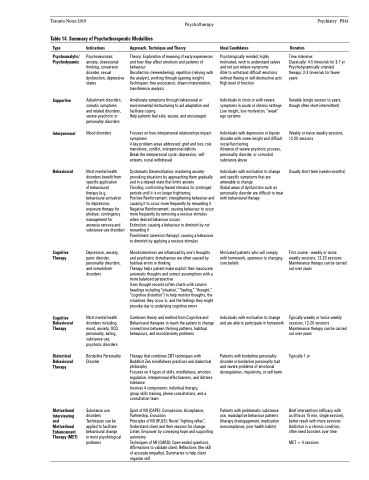Page 1205 - TNFlipTest
P. 1205
Toronto Notes 2019 Psychotherapy Table 14. Summary of Psychotherapeutic Modalities
Psychiatry PS41
Type
Psychoanalytic/ Psychodynamic
Supportive
Interpersonal
Behavioural
Indications
Psychoneuroses; anxiety, obsessional thinking, conversion disorder, sexual dysfunction, depressive states
Adjustment disorders, somatic symptoms and related disorders, severe psychotic or personality disorders
Mood disorders
Most mental health disorders benefit from specific application
of behavioural
therapy (e.g. behavioural activation for depression; exposure therapy for phobias; contingency management for anorexia nervosa and substance use disorder)
Depression, anxiety, panic disorder, personality disorders, and somatoform disorders
Most mental health disorders including; mood, anxiety, OCD, personality, eating, substance use, psychotic disorders
Borderline Personality Disorder
Substance use disorders
Techniques can be applied to facilitate behavioural change in most psychological problems
Approach, Technique and Theory
Theory: Exploration of meaning of early experiences and how they affect emotions and patterns of behaviour
Recollection (remembering), repetition (reliving with the analyst), working through (gaining insight) Techniques: free association, dream interpretation, transference analysis
Ameliorate symptoms through behavioural or environmental restructuring to aid adaptation and facilitate coping
Help patients feel safe, secure, and encouraged
Focuses on how interpersonal relationships impact symptoms
4 key problem areas addressed: grief and loss, role transitions, conflict, interpersonal deficits
Break the interpersonal cycle: depression, self- esteem, social withdrawal
Systematic Desensitization: mastering anxiety- provoking situations by approaching them gradually and in a relaxed state that limits anxiety
Flooding: confronting feared stimulus for prolonged periods until it is no longer frightening
Positive Reinforcement: strengthening behaviour and causing it to occur more frequently by rewarding it Negative Reinforcement: causing behaviour to occur more frequently by removing a noxious stimulus when desired behaviour occurs
Extinction: causing a behaviour to diminish by not rewarding it
Punishment (aversion therapy): causing a behaviour to diminish by applying a noxious stimulus
Moods/emotions are influenced by one’s thoughts and psychiatric disturbances are often caused by habitual errors in thinking
Therapy helps patient make explicit their inaccurate automatic thoughts and correct assumptions with a more balanced perspective
Uses thought records (often charts with column headings including “situation,” “feeling,” “thought,” “cognitive distortion”) to help monitor thoughts, the situations they occur in, and the feelings they might provoke due to underlying cognitive errors
Combines theory and method from Cognitive and Behavioural therapies to teach the patient to change connections between thinking patterns, habitual behaviours, and mood/anxiety problems
Therapy that combines CBT techniques with Buddhist Zen mindfulness practices and dialectical philosophy
Focuses on 4 types of skills: mindfulness, emotion regulation, interpersonal effectiveness, and distress tolerance
Involves 4 components: individual therapy,
group skills training, phone consultations, and a consultation team
Spirit of MI (CAPE): Compassion, Acceptance, Partnership, Evocation
Principles of MI (RULE): Resist “righting reflex”, Understand client and their reasons for change, Listen, Empower by conveying hope and supporting autonomy
Techniques of MI (OARS): Open-ended questions, Affirmations to validate client, Reflections (the skill of accurate empathy), Summaries to help client organize self
Ideal Candidates
Psychologically minded, highly motivated, wish to understand selves and not just relieve symptoms
Able to withstand difficult emotions without fleeing or self-destructive acts High level of function
Individuals in crisis or with severe symptoms in acute or chronic settings Low insight, low motivation, ”weak” ego systems
Individuals with depression or bipolar disorder with some insight and difficult social functioning
Absence of severe psychotic process, personality disorder, or comorbid substance abuse
Individuals with motivation to change and specific symptoms that are amenable to change
Global areas of dysfunction such as personality disorder are difficult to treat with behavioural therapy
Motivated patients who will comply with homework, openness to changing core beliefs
Individuals with motivation to change and are able to participate in homework
Patients with borderline personality disorder or borderline personality trait and severe problems of emotional dysregulation, impulsivity, or self-harm
Patients with problematic substance use, maladaptive behaviour patterns (therapy disengagement, medication noncompliance, poor health habits)
Duration
Cognitive Therapy
Cognitive Behavioural Therapy
Dialectical Behavioural Therapy
Motivational Interviewing and Motivational Enhancement Therapy (MET)
First course - weekly or twice weekly sessions, 12-20 sessions Maintenance therapy can be carried out over years
Typically weekly or twice weekly sessions, 12-20 sessions Maintenance therapy can be carried out over years
Typically 1 yr
Brief interventions (efficacy with as little as 15 min, single session), better result with more sessions Addiction is a chronic condition, often need boosters over time
MET = 4 sessions
Time intensive:
Classically: 4-5 times/wk for 3-7 yr Psychodynamically oriented therapy: 2-3 times/wk for fewer years
Variable (single session to years, though often short-intermittent)
Weekly or twice weekly sessions, 12-20 sessions
Usually short term (weeks-months)


